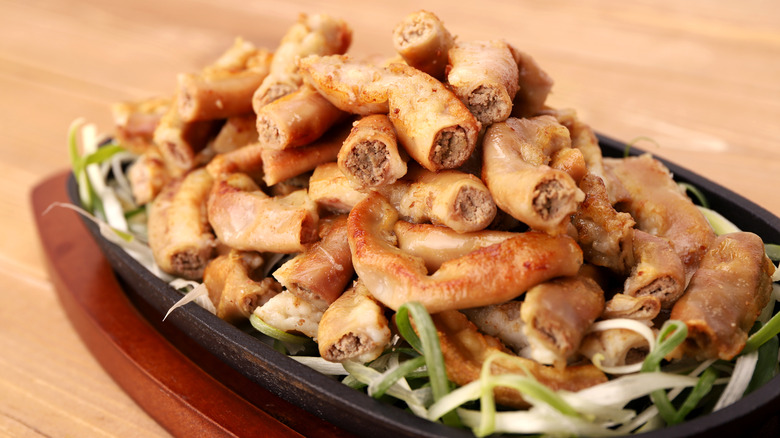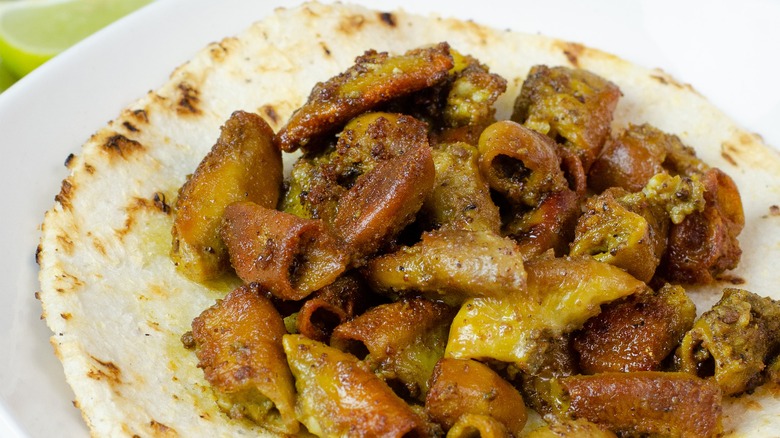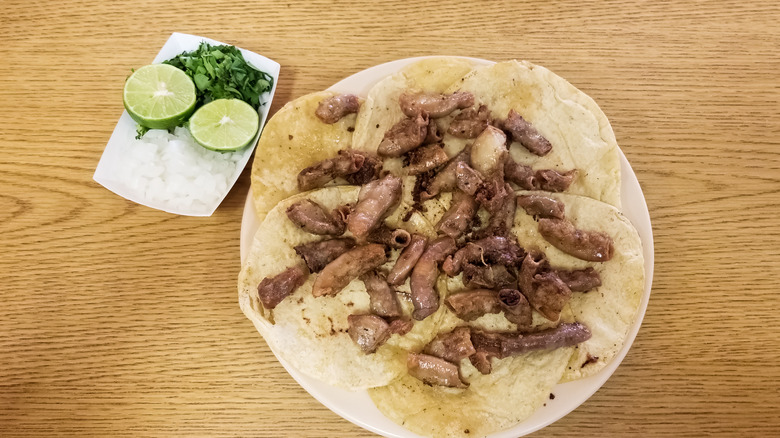Beef tripas a popular ingredient in Mexican cuisine, refers to beef intestine that has been thoroughly cleaned boiled, and fried or grilled. Despite sounding unappealing at first, tripas offer a unique, delicious flavor and texture when prepared properly. In this article, we’ll explore the origins, preparation, taste, nutrition, and culinary uses of beef tripas.
A Brief History of Beef Tripas
The tradition of eating beef tripas has its roots in Mexico, where intestine has been consumed for generations as part of the country’s rich culinary heritage. The small intestine was favored for its smooth texture compared to tripe from other parts of the cow. After a careful cleaning process, tripas emerged as a versatile and coveted ingredient across the country.
The practice of preparing tripas spread beyond Mexico as well. In the Philippines, beef tripas are known as isaw and are a popular street food. Korean cuisine also utilizes pork and beef intestine in the dish known as gopchang.
How to Prepare Beef Tripas
Preparing beef tripas requires meticulous cleaning before cooking. First, the intestine is scraped and scrubbed with coarse salt, then rinsed and scraped again with a knife to remove any residual waste or lining. To finalize the cleaning, tripas are soaked in an acidic vinegar solution.
Once cleaned, the tripas are boiled for 30 minutes up to an hour depending on thickness. The boiling liquid, flavored with garlic, onion, oregano, cilantro, and other spices, infuses the tripas with flavor.
After boiling, the tripas are sliced into pieces and fried or grilled until crispy on the outside and tender inside. When fried, pork lard is traditionally used to achieve maximum crispness.
The Distinct Taste of Tripas
When cooked right, beef tripas offer a uniquely savory, meaty taste. The interior remains velvety and tender, while the exterior gets crispy and takes on the flavors of seasonings and spices used. The overall taste has been described as mildly sweet and iron-rich.
The traditional preparation style allows the tripas to retain some firmness while avoiding a rubbery texture. When overcooked, the intestines can become tough.
Nutrition Profile of Beef Tripas
Despite the unfamiliarity, beef tripas deliver a solid nutritional boost. They are an excellent source of protein, iron, zinc, and B vitamins. The intestines are rich in cholesterol as well, so tripas are best consumed in moderation. Overall, when incorporated as part of a balanced diet, tripas offer a healthy meat choice.
The Culinary Uses of Tripas
In Mexican cuisine the most iconic preparation is tacos de tripas. The crispy fried intestines are served in soft corn tortillas and topped with salsa, onions cilantro, and other taco garnishes.
Beyond tacos, tripas work well in burritos, quesadillas, soups, stews, and even pizza toppings. Their versatility allows them to be incorporated seamlessly into various dishes. The intestines can also be chopped up and used as a crispy, flavorful addition to homemade salsas and guacamole.
Trying Beef Tripas for the First Time
If you’ve never tasted tripas before, authentic Mexican restaurants are the best places to sample the intestine in dishes like tacos, sopes, and grilled appetizers. Start with a small amount along with other ingredients and flavors you enjoy. This allows the tripas to complement rather than overpower the other textures and tastes.
When making tripas at home, be sure to source cleaned intestines from a butcher you trust. Follow recipes closely, especially frying and boiling times. Achieving the right tenderness on the inside and crispness outside brings out the appeal that has made tripas an enduring delicacy.
FAQs About Beef Tripas
Are beef tripas difficult to find?
Tripas may not be common at regular grocery stores but can be sourced from Mexican markets or butchers specializing in offal. Many Mexican restaurants may sell cleaned tripas as well.
What’s the difference between beef tripas and beef tripe?
Beef tripas come specifically from the small intestine and have a smooth lining. Tripe refers to the stomach lining instead and has a more honeycombed texture.
Do beef tripas smell bad?
When thoroughly cleaned and cooked, beef tripas have a mild meaty aroma similar to organ meats. Any strong odors are usually eliminated through proper preparation.
Can you eat beef tripas raw?
It is not recommended to eat raw beef tripas due to the potential exposure to bacteria that cooking neutralizes. Always cook tripas fully before consuming.
What part of the cow are beef tripas from?
Beef tripas are sourced from the small intestine of the cow versus other intestines or the stomach. The small intestine offers the smoothest lining when cleaned.
Conclusion
While eating intestine may seem intimidating initially, beef tripas offer a delicious flavor, meaty crunch, and dose of nutrition when prepared properly. Their versatility allows them to shine in tacos, stews, soups, and more, contributing a uniquely savory taste. With an open mind and palate, beef tripas prove themselves as an adventurous and tasty culinary experience.

How tripas are prepared

Since tripas are sourced from the digestive tract of an animal, they require several cleaning steps before preparation. First, the intestine is rubbed down with coarse salt to remove any dirt and impurities. Next, its further scraped with a sharp knife, ensuring theres nothing adhered to a coating. And finally, a vinegar soak utilizes an acidic environment to finalize the cut for cooking. Note that many butchers already sell the cut cleaned.
Before tripas are fried, theyre first boiled in order to both cook through the meat, as well as infuse flavor. The boiling liquid usually builds upon an onion, garlic, salt, and dried pepper base, further accentuated with flavorings like cilantro, oregano, coriander, and cloves. The exact constituents are highly malleable, and the flavor can be changed according to ones taste. Depending on the thickness of the tripas, the organ is boiled anywhere from 30 minutes to an hour until it reaches a well-done internal temperature of 160 degrees Fahrenheit. After boiling, the tripas can be stored for up to two days before consumption.
Mexican dishes with tripas

The most popular way to consume tripas is in taco form, a fixture on taqueria menus across Mexico and the U.S. For this crispy application, the boiled intestines are first sliced into small two-inch pieces. Theyre then traditionally fried using lard in large wok-like pans called discos; however, the cooking can also take place in a pan. After draining some of the excess oil, the tripas are seasoned and placed into a warm corn tortilla. Theyre often served alongside vegetables, like sautéed peppers, mushrooms, onions, fresh avocado, a vibrant, spicy salsa, and pico de gallo.
In addition to frying, tripas are also grilled on an open flame, as well as baked to a crispy consistency. When not designated for tacos, theyre enjoyed as a side dish in a spread of grilled meats. Alternatively, they can also be used as an addition to salsas and guacamole, adding a savory flavor and crunchy textural element.
